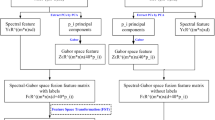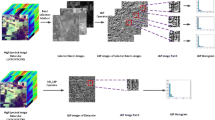Abstract
Recently, local binary patterns (LBP) coupled with principal component analysis has been developed for feature extraction of hyperspectral imagery, which has shown success over traditional methods but is limited in physical meaning representation due to the noise bands existing in hyperspectral data. In order to preserve the intrinsic geometrical structure of original data, we propose a segmented LBP (SLBP) to group correlative bands and then extract spatial-spectral features from each band group. The proposed approach employs the LBP operator on independent subspaces to characterize local texture information and distinct spectral signatures, along with a decision fusion system further improving discriminant power. The proposed approach is compared with several traditional and state-of-the-art methods on two benchmark datasets (i.e., the Indian Pines dataset and the Salinas Valley dataset). Experimental results demonstrate that the proposed SLBP strategy can yield superior classification performance (96.8% for the Indian Pines dataset with an improvement of approximately 6.4% and 4.2% when compared with LBP and MELBP, respectively; 98.1% for the Salinas Valley dataset with an improvement of approximately 3.5% and 1.3% compared with LBP and MELBP, respectively).










Similar content being viewed by others
References
Fu, W., Li, S., Fang, L., Kang, X., & Benediktsson, J. A. (2016). Hyperspectral image classification via shape-adaptive joint sparse representation. IEEE Journal of Selected Topics Applied Earth Observations and Remote Sensing, 9(2), 556–567.
Zhang, G., Sun, H., Xia, G., & Sun, Q. (2016). Multiple kernel sparse representation-based orthogonal discriminative projection and its cost-sensitive extension. IEEE Transactions on Image Processing, 25(9), 4271–4285.
Li, J., Zhang, H., & Zhang, L. (2015). Efficient superpixel level multitask joint sparse representation for hyperspectral image classification. IEEE Transactions on Geoscience and Remote Sensing, 53(10), 5338–5351.
Prasad, S., Li, W., Fowler, J. E., & Bruce, L. M. (2012). Information fusion in the redundant-wavelet-transform domain for noise-robust hyperspectral classification. IEEE Transactions on Geoscience and Remote Sensing, 50(9), 3474–3486.
Du, Q., & Yang, H. (2008). Similarity-based unsupervised band selection for hyperspectral image analysis. IEEE Geoscience Remote Sensing Letters, 5(4), 564–568.
Prasad, S., & Bruce, L. M. (2008). Decision fusion with confidence-based weight assignment for hyperspectral target recognition. IEEE Transactions on Geoscience Remote Sensing, 46(5), 1448–1456.
Sun, K., Geng, X., Ji, L., & Lu, Y. (2014). A new band selection method for hyperspectral image based on data quality. IEEE Journal of Selected Topics Applied Earth Observations and Remote Sensing, 7(6), 2697–2703.
Wang, J., Zhang, K., Wang, P., Madani, K., & Sabourin, C. (2017). Unsupervised band selection using block-diagonal sparsity for hyperspectral image classification. IEEE Geoscience Remote Sensing Letters, 14(11), 2062–2066.
Martinez, A. M., & Kak, A. C. (2001). PCA versus LDA. IEEE Transactions on Pattern Analysis and Machine Intelligence, 23(2), 228–233.
Kang, X., Xiang, X., Li, S., & Benediktsson, J. A. (2017). PCA-based edge-preserving features for hyperspectral image classification. IEEE Transactions on Geoscience Remote Sensing, 55(12), 7140–7151.
Licciardi, G. A., & Chanussot, J. (2015). Nonlinear PCA for visible and thermal hyperspectral images quality enhancement. IEEE Geoscience Remote Sensing Letters, 12(6), 1228–1231.
Jiang, J., Ma, J., Chen, C., Wang, Z., Cai, Z., & Wang, L. (2018). Super PCA: A superpixelwise PCA approach for unsupervised feature extraction of hyperspectral imagery. IEEE Transactions on Geoscience Remote Sensing, 56(8), 4581–4593.
Sugiyama, M. (2007). Dimensionality reduction of multimodal labeled data by local Fisher discriminant analysis. Journal of Machine Learning Research, 8(5), 1027–1061.
Ye, Z., Bai, L., & Nian, Y. (2017). Decision fusion for hyperspectral image classification based on multiple features and locality-preserving analysis. European Journal of Remote Sensing, 5, 166–178.
Li, W., Prasad, S., & Fowler, J. E. (2014). Hyperspectral image classification using Gaussian mixture models and Markov random fields. IEEE Geoscience Remote Sensing Letters, 11(1), 153–157.
Camps-Valls, G., & Bruzzone, L. (2005). Kernel-based methods for hyperspectral image classification. IEEE Transactions on Geoscience Remote Sensing, 43(6), 1351–1362.
Tarabalka, Y., Fauvel, M., Chanussot, J., & Benediktsson, J. A. (2010). SVM- and MRF-based method for accurate classification of hyperspectral images. IEEE Geoscience Remote Sensing Letters, 7(4), 736–740.
Huo, L., & Tang, P. (2011). Spectral and Spatial classification of hyperspectral data using SVMs and Gabor texture. In Proceedings of IGARSS (pp. 1708–1711).
Zhang, L., Zhang, L., Tao, D., & Huang, X. (2012). On combining multiple features for hyperspectral remote sensing image classification. IEEE Transactions on Geoscience Remote Sensing, 50(3), 879–893.
Ojala, T., Pietikäinen, M., & Mäenpää, T. T. (2002). Multiresolution gray-scale and rotation invariant texture classification with local binary pattern. Transactions on Pattern Analysis and Machine Intelligence, 24(7), 971–987.
Li, W., Chen, C., Su, H., & Du, Q. (2015). Local binary patterns and extreme learning machine for hyperspectral imagery classification. IEEE Transactions on Geoscience Remote Sensing, 53(7), 3681–3693.
Jia, S., Hu, J., Zhu, J., Jia, X., & Li, Q. (2017). Three-dimensional local binary patterns for hyperspectral imagery classification. IEEE Transactions on Geoscience Remote Sensing, 55(4), 2399–2413.
Jia, S., Deng, B., Zhu, J., Jia, X., & Li, Q. (2018). Local binary pattern-based hyperspectral imagery classification with superpixel guidance. IEEE Transactions on Geoscience Remote Sensing, 56(2), 749–759.
Guo, Z., Zhang, L., & Zhang, D. (2010). A completed modeling of local binary pattern operator for texture classification. IEEE Transactions on Image Processing, 19(6), 1657–1663.
Huang, L., Chen, C., Li, W., & Du, Q. (2016). Remote sensing image scene classification using multi-scale completed local binary patterns and Fisher vectors. Remote Sensing, 8(6), 483.
Ye, Z., Fowler, J. E., & Bai, L. (2017). Spatial-spectral hyperspectral classification using local binary patterns and Markov random fields. Journal of Applied Remote Sensing, 11(3), 035002.
Dundar, T., & InceSparse, T. (2019). Representation-based classification using multiscale superpixels and guided filter. IEEE Geoscience and Remote Sensing Letters, 16(2), 246–250.
Xia, J., Bombrun, L., Berthoumieu, Y., Germain, C., & Du, P. (2017). Spectral-spatial rotation forest for hyperspectral image classification. IEEE Journal of Selected Topics in Applied Earth Observations and Remote Sensing, 10(10), 4605–4613.
Pu, H. Y., Chen, Z., Wang, B., & Jiang, G. M. (2014). A novel spatial-spectral similarity measure for dimensionality reduction and classification of hyperspectral imagery. IEEE Transactions on Geoscience and Remote Sensing, 52(11), 7008–7022.
Jiang, J., Ma, J., Wang, Z., Chen, C., & Liu, X. (2019). Hyperspectral image classification in the presence of noisy labels. IEEE Transactions on Geoscience Remote Sensing, 57(2), 851–865.
Acknowledgements
This research was supported by the National Natural Science Foundation of China (41601344, 61803042) and Chongqing Research Program of Basic research and Frontier Technology (cstc2016jcyjA0539). The authors would also like to thank the editor and the anonymous reviewers for their insightful comments and suggestions in improving the quality of this paper.
Author information
Authors and Affiliations
Corresponding author
Additional information
Publisher's Note
Springer Nature remains neutral with regard to jurisdictional claims in published maps and institutional affiliations.
Rights and permissions
About this article
Cite this article
Ye, Z., Dong, R., Bai, L. et al. Hyperspectral Image Classification Based on Segmented Local Binary Patterns. Sens Imaging 21, 15 (2020). https://doi.org/10.1007/s11220-020-0274-7
Received:
Revised:
Published:
DOI: https://doi.org/10.1007/s11220-020-0274-7




